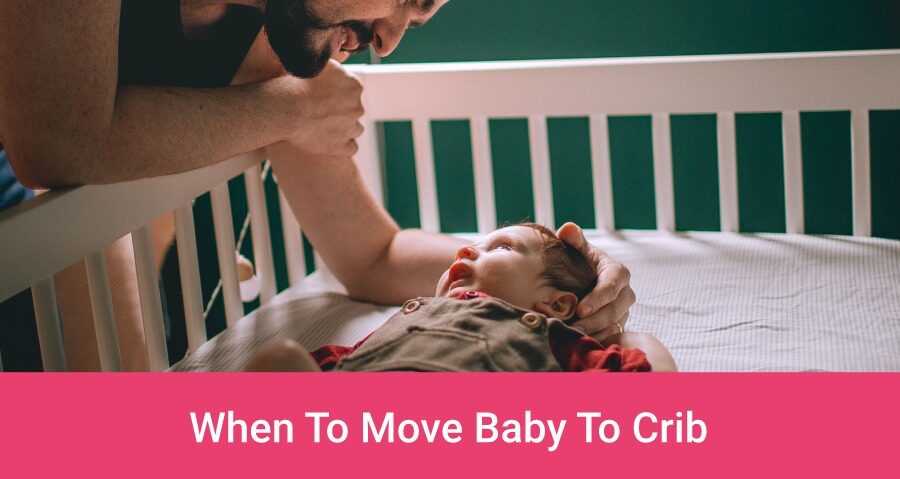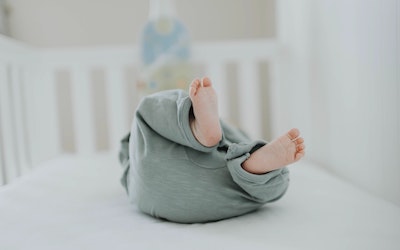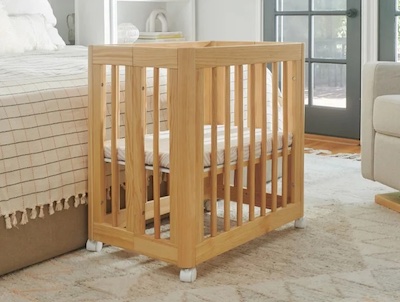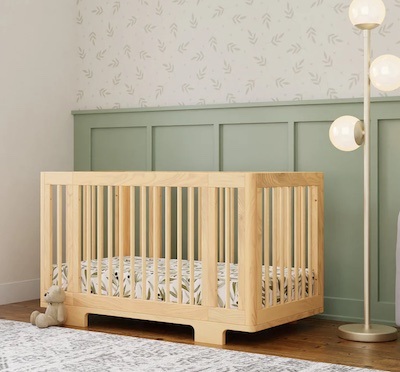
Article By Edna Skopljak – Medical Doctor (MD)
If you are a parent, especially a first-time parent with a newborn at home, you may feel stressed, overwhelmed, and anxious. I have been there – and I felt that.
These first days and months home with my baby are still a bit “foggy” due to sleep deprivation and constant worry over everything. I calculated hours (and minutes) of the baby’s sleep, scheduled naps, and counted ounces of milk. I have to admit I Googled everything. And yes – every little thing seemed like a big deal when I was a brand-new parent. And it was completely understandable.
I know that baby sleep is especially an obsession for new parents. It is not that difficult to figure out why. Right?
One of the important dilemmas is where your little one sleeps. American Academy of Pediatrics (AAP) and their recommendations regarding safe sleep in babies, the baby should sleep in their own crib as of day one, in the same room with their parents1. And no – there is no such thing as “too early for the crib.”
However, many parents may, at first, opt for bassinets. This is fine for the first few months because it feels more like a snuggle womb. On the other side, a crib offers way more space. So, once the baby outgrows the bassinet, parents may be worried about how this change will affect their baby’s sleep. Furthermore, they may need clarification about when the baby can be transferred to the crib.
You may think it could be catastrophic, but actually – the transition from a bassinet to the crib is possible without drama.
I will try to help you in this process, as I know the help with baby sleep is very welcome.
This article is not a substitute for medical advice.
When To Move Baby To Crib – Signs That Baby Is Ready For Transition
Babies usually sleep most of the day and night. You may notice how they are getting bigger every day. They change a lot – so do their routines and habits.
Moving from the bassinet to the crib is a big milestone to achieve – and it can be scary. It may seem difficult for both the parents and the babies. In the end, they need to change their sleeping environment.
Most parents wonder when the right time is to switch their baby from sleeping in the same room as them to sleeping in a crib in the baby’s room.
This depends on your little one. They will show you they are ready – the clue is to know what to look for.
Age
Most babies (of lucky parents) will sleep through the night between 4 and 6 months. They don’t require night feeds at this age, so they start sleeping for longer stretches of uninterrupted sleep and learn falling asleep on their own.
Of course, the age for such a transition is not completely clear. However, most babies will be ready for it by six months.
Moreover, this is when they actually outgrow their bassinet, too. You may notice that your little one actually needs bigger space.
There is one more sign that’s it’s time to transition your baby from bassinet to a crib: around 4-6 months of age baby starts to roll over and push up on their knees. At this point bedside sleepers or bassinets are no longer safe and you should move baby to a crib2.
Weight
The bassinets have their weight limits. For some, that limit is as low as 10-15 pounds, but some of them may hold the babies up to 25 pounds of baby’s weight.
Check the instruction manual or manufacturer’s website regarding the weight your bassinet can acquire.
If you are not sure about the weight limit – plan the transition to the crib once your baby reaches 15 pounds.
Baby’s Movements During The Night
Try to follow how much your baby is moving during their nighttime sleep. If they are changing positions and/or rolling over, it’s time for the transition to the crib.
As the bassinet doesn’t offer a lot of space, nighttime motions can endanger your baby as they can be smothered against the sides of the bassinet.
Keep in mind that – even if your little one is still under the weight or size limit – if he starts to roll over (or sit!), it is time for you to consider transitioning them to their crib.
Night Wakings
How much does your baby actually sleep when sleeping next to you? Do you need to wake up every few hours, or are you having more prolonged stretches of sleep?
Suppose your baby started waking up more frequently at night – especially at abnormal times. In that case, the baby is habitual of their bassinet or bedside sleeper – but not entirely comfortable. This is a sign for baby’s transition to a new sleeping environment.
Baby Has Overgrown Bassinet
Weight is not merely the alarm to transition your baby transition baby to the crib. If you feel your little one is cramped or stuck inside their bassinet or co-sleeper – again – it’s time for the crib.
If the babies don’t have about two inches of space at the top and the bottom, they may not enjoy the time in their bassinet anymore. You may find them in an uncomfortable position, or they are crankier than usual. You may even see them kicking the sides of the bassinet during the night.
Those are alarming moments for you to prepare them for the transition.
If you’re worried that your baby is not ready for the crib – read this article with tips.

Safe Crib – How To Prepare Sleeping Space For Baby
As a parent – of course – the first thing you have to take care of is the baby’s safety. Before you switch your baby to the crib – make sure the crib is safe for your little one. How?
- Choose the crib that complies with the safety standards
Above all, again – choose the crib that meets all the safety standards (by the Consumer Product Safety Commission). Before you consider buying the crib for its looks, price, or other factors which may influence your decision, first make sure you are buying a safe crib from a reliable brand.
- Choose the crib of the right size
There is a regular crib and a mini crib, with the dimensions set by the law. Whichever you choose, make sure that the crib bars are 2 3/8 inches (6 centimeters) wide in order to protect your baby from falling out, and so they cannot trap their head between the bars.
- Choose the right mattress and sheets
Use a firm mattress and tight-fitting crib sheets inside the baby’s crib for your little one’s safety. Buying a firm crib mattress with optimum back support for your baby and ensuring it fits the crib snugly is essential.
Make sure the mattress is tight enough that you cannot fit more than two fingers between the mattress and the crib’s sides. In that way, you are creating a safe sleeping space for your baby, without risking suffocation and becoming trapped in the gaps around the mattress.
Tight fitting sheet is also important when creating safe sleep space – you don’t want any excess of fabric that could pose a suffocation risk. Check out our article about choosing safest crib sheet (especially for baby’s with sensitive skin and eczema).
- Prepare the (baby’s) room
Whether you plan to put your baby in a separate room or you will be room sharing, you need to prepare their sleep environment. Let them have their own space in either their own room or the space you prepare for their crib in your bedroom.
Once your baby starts sleeping in the crib, you will probably want to see or hear them, so you can be reassured they’re fine. A baby monitor seems like a good option here.
Blackout curtains are also a good idea. Babies need to know their sleep time – and they actually sleep better in the dark. Therefore – prepare the room – so you can be sleeping peacefully, too!
- Don’t put anything inside the crib!
Although you may think extra pillows, blankets, bumper pads, or teddy bears (or anything your baby loves) look very cute or will help your baby fall asleep – please don’t put those inside your baby’s crib. These are suffocation hazards for your baby.
Their sleep space should be free of any loose blankets, stuffed animals, or pillows. It is actually proven that these may increase the risk of sudden infant death syndrome (SIDS).

How To Transition Baby From Bassinet To Crib
You already know what are the signs that you should transition your baby from bassinet to crib, now it’s time to find out HOW to actually do it!
1. Set Up The Crib In Your Bedroom
The transition from bassinet to a crib will be much easier if you continue room-sharing (at least until your baby is 12 months old). Before you move baby to their own room, set up the crib in your bedroom. It will be also easier for you – with the night feedings!
2. Prepare Their Sleep Space
Ensure the crib is really comfortable for your little one. Don’t put them in the crib if the sheets are too cool, this may wake them up. If your baby enjoys swaddling, try transitioning them to the sleep sack to keep your baby warm during the night – remember, no blankets yet.
Also, if your baby is used to being near you when falling asleep, try sleeping on the crib sheets so the sheets smell like you. You can introduce white noise sound machine, as the babies are used to loud white noise from being in the womb. It actually comforts them. Keep the room temperature cool and dress your little one comfortably.
Of course, as previously described, think about safety first!
3. Make The Transition Gradual
Ease your little one into the crib. First, let your baby take naps in the crib. Then, you may let them play there.
Small steps – give them enough time to get familiar with the crib, but also to get used to the new sleeping environment. It is very important to make this transition gradually. It is also important to bear in mind that some babies will need only few nights, while other babies will need about a week – or even longer, to fully transition to the crib3.
Your baby needs to feel comfortable in the crib before fully transitioning. Take it slow!
4. Choose The Sleep Training Method
You may think of sleep train if you transition your baby from the bassinet to the crib after they turn four months.
Choose the one that works best for your family – and stay consistent. Your little one will become more familiar with the crib with the more time spent in it.
5. Keep Your Bedtime Routine
When transitioning a baby from a bassinet to a crib, it is important not to change their regular bedtime routine (if you’ve already created it). Little ones usually have quite predictable sleep patterns. Also, they love consistency!
Once you get to know your babies’ sleep cycles – create a bedtime routine around them. And – more importantly – stick to it.
Bedtime routines are also helpful in transitioning the baby from the bassinet to the crib, as the baby feels more secure. Why? Because they recognize their bedtime routine and associate it with sleep. It comforts them.
6. Prepare Yourself
While you may think you must prepare your baby first, you have to be aware that you can have a hard time, too. So, get ready for the transition process – and don’t give up on the slightest fuss.
Try to stay calm and objectively observe how your baby is doing by getting familiar with the new sleep environment. Don’t react to their every sound. That is why baby monitors are a great idea4. Stay patient!
Tips For Making The Transition To Crib Easier
If you are having a hard time transitioning your baby to a crib, there are some tips to make it easier for both of you.
In order to help your baby to get comfortable with their new sleep space, introduce them to the crib gradually. Get your crib ready and safe (as previously described), and have a consistent bedtime routine. It is the predictability that comforts the baby. They will soon start associating the crib with sleep time.
Make the nursery familiar by spending time together in their new space. Make them comfortable by introducing sound machines, and creating a good sleeping environment. For your own peace – you can also use baby monitors.

When To Move baby To Crib – FAQ
I know that you may have many questions and doubts regarding baby sleeping. And – as for transitioning the baby to a crib – there are some frequently asked questions I will try to answer.
How Long Do Babies Sleep In Bassinet?
How long babies actually sleep in bassinet depends on the bassinet, its size, and weight limit, and also on your baby: how fast they grow and reach some developmental milestones (like rolling over and pushing up on their hands). Generally, the babies may sleep in their bassinets up to 4-6 months.
What Age Should I Move My Baby To A Crib?
If your baby have been sleeping in bassinet from birth (and not the crib), make sure you start transitioning your baby to a crib between 4 and 6 months of age.
Is 2 Months Too Early To Move Baby To Crib?
2 months doesn’t have to be too early for moving baby to crib, if this transition is fine for you and your little one.
However, it would be easier waiting for at least three months of baby’s age. For a two-months-old, co-sleeper, bedside sleeper, or cradle would be better choices, but of course you can start using a crib even from day one!
Is 4 Months Too Early To Move Baby In Own Room?
Once your baby gets familiar with the crib, try to transition them slowly and gradually to their own room. Spend some time together in there, to make them familiar with their new space. Theoretically, it is possible at 4 months – however – ideally, you can do so when the baby is around 6-7 months of age.
How Long Do Babies Use A Crib?
Cribs are an investment for longer time periods. Usually babies use a crib up to 1.5-2 years of age. When they are already able to stand up and try to climb out of the crib, it’s time for the transition to bed. What’s noteworthy, there are some tall cribs that can keep your little one from climbing out for longer time.
I recommend getting a convertible crib, that can be turned into a toddler bed – this way you can use it even throughout preschool years!
Article By Edna Skopljak
Edna Skopljak is Medical Doctor (MD) who works in University Medical Centre in Ljubljana. She’s a She also worked as an editor at BJBMS medical journal for several years. She wrote content for several health-related websites and the BJBMS blog. She’s a mom of a 15-month-old.
The purpose of this article is informative. It’s not a substitute for professional medical advice or medical care. Remember: safety first! Consult your doctor/pediatrician in case of any doubts. The author of this article does not accept any responsibility for any liability, loss or risk, personal or otherwise, incurred as a consequence, directly or indirectly, from any information or advice contained here.
Resources:
https://www.healthychildren.org
https://www.whattoexpect.com
https://www.webmd.com/
https://www.nanit.com/
Pictures of the baby crib belong to Babyletto Brand. Source: https://babyletto.com/

